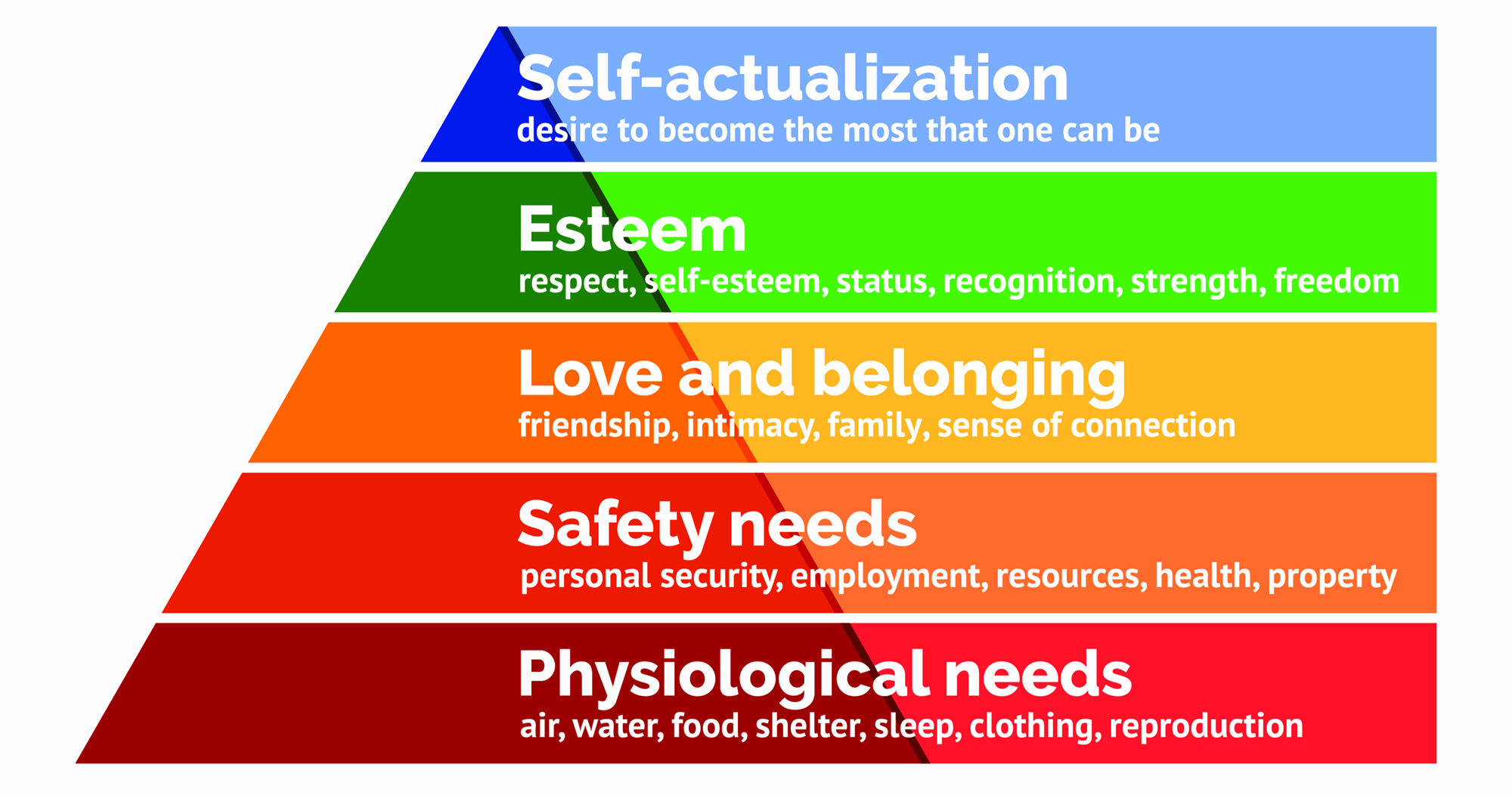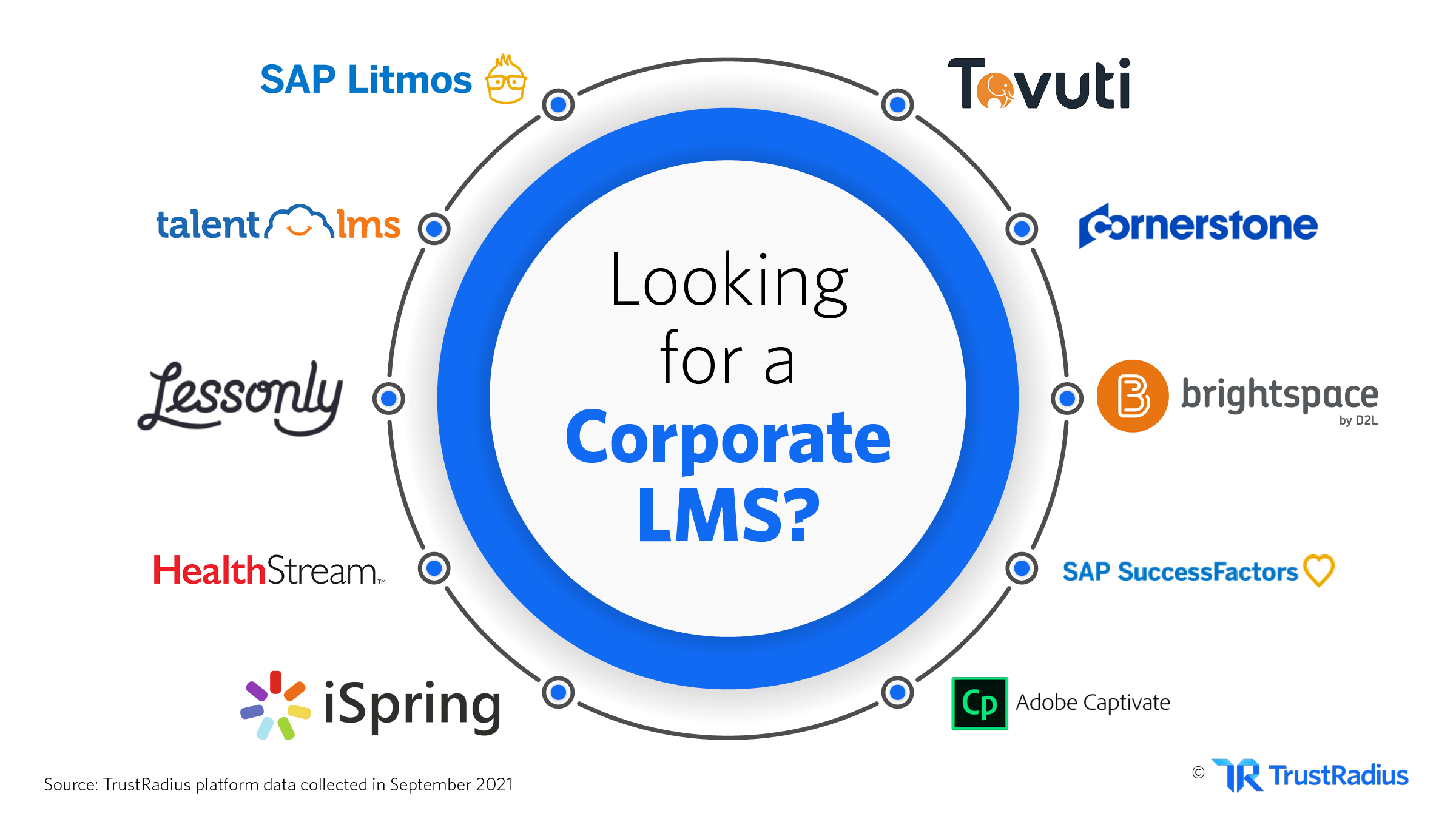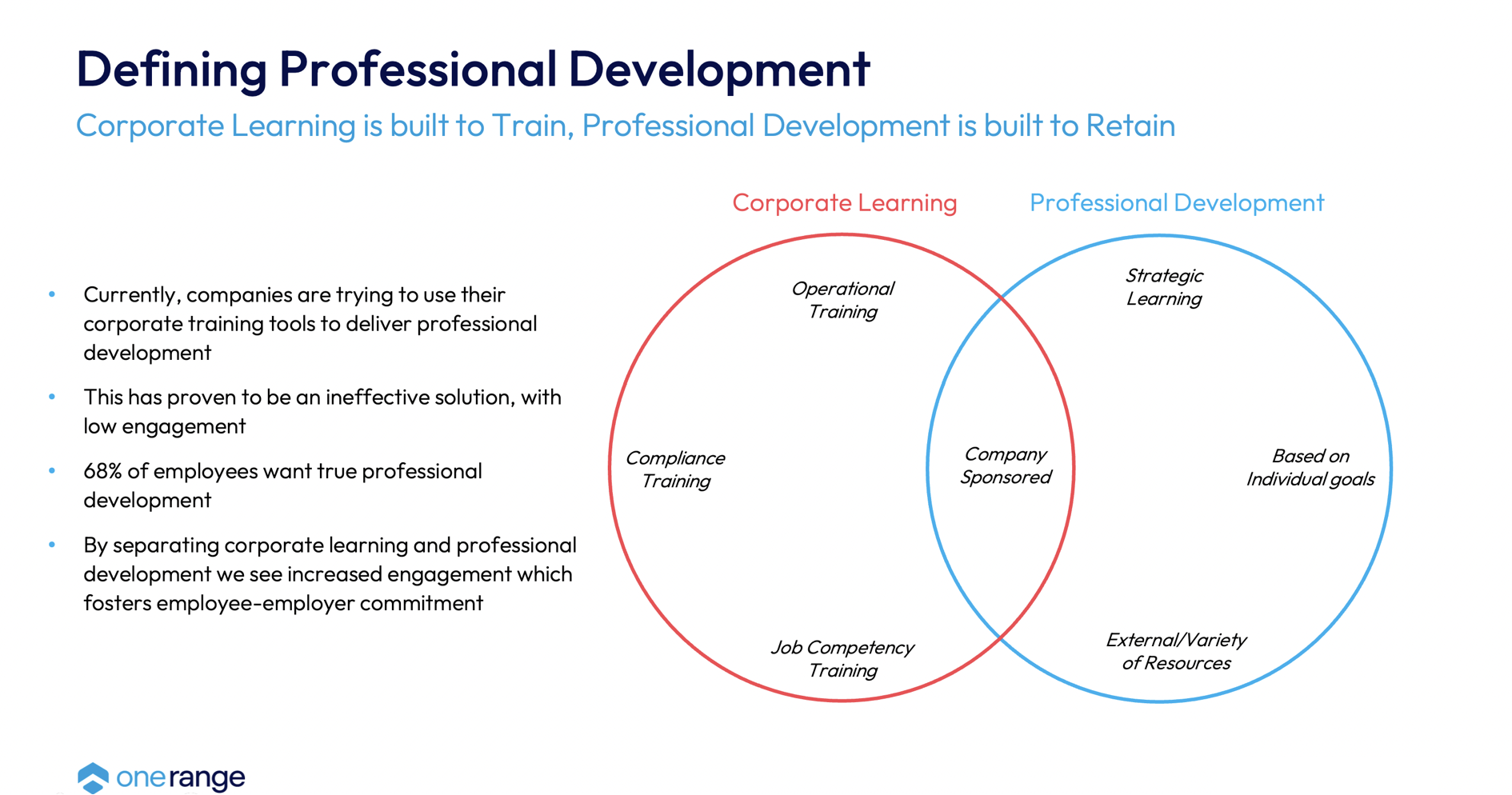Photo by Accuray
If you’re in the business of people development, you know that not all learning is the same. There are dull, cookie-cutter corporate training sessions that make employees roll their eyes and groan, and inspiring, highly-customized workshops that end with colleagues giving each other hugs and high-fives. And, of course, everything in between.
In this article, we’re going to explain the two main categories of learning and development (L&D): corporate learning and professional development. Both are necessary and important, but too many companies focus on corporate learning at the expense of professional development. Out of the more than $360B spent annually on learning and development, the vast majority goes to corporate training.
This is problematic, because 68% of employees say they want true professional development – not another corporate learning session. By the end of this post, you’ll understand the difference between training and development, and how the latter can help you grow your business and your people.
Corporate learning is built to train
Corporate learning is all about helping employees do their current jobs better. It can include activities such as operational training, which guides employees in how to use core systems and equipment. An example of this might be learning how to use a piece of payment processing software or, if you’re a barista, learning how to use an espresso machine.
Another very important type of corporate learning is compliance training, which prepares workers to adhere to state, federal, and industry regulations and standards. Examples of compliance training include sexual harassment workshops and, going back to our barista example, learning the regulations around food safety to ensure a clean, hygienic restaurant environment.
The last type of corporate learning is competency training, or task-based training that prepares workers to complete core job functions. For example, a salesperson might learn how to create a regional outreach plan. Returning again to our barista example, a new employee in a coffee shop would learn the difference between a latte, a cappuccino, and an americano, and the steps required to prepare each.
The primary delivery system for corporate learning is a Learning Management System (LMS)
The location that learning takes place can be as important – and telling – as the content itself. Most corporate learning is delivered through a Learning Management System (LMS), either partly or entirely.
An LMS is an internal, usually closed software system. It may be connected to other internal systems such as a company intranet, but it is rarely connected to external systems. Examples of some commonly used corporate LMSes are Cornerstone, Absorb LMS, Rippling, WorkDay Human Capital Management, ADP Workforce Now, and SAP Litmos.
The courses on an LMS are often developed by subject matter experts from the company, but may also include standardized modules produced by external groups, such as diversity training. The courses are generally prescriptive, limited in selection, and lecture-based, with limited opportunities for learner engagement or personalization.
A Human Resources (HR) leader can determine which courses specific employees have access to based on their role, and they can set deadlines for when employees must complete a required course.
Importantly, LMSes are designed to compel compliance and closely monitor participation. The goal is to track completion of course content, so HR leaders have dashboards and tools to see who has, and hasn’t, completed required courses.
Corporate learning enables workers to succeed today
Corporate learning plays an important role in enabling employees to succeed in their current jobs. It can help with basic skills and workforce development, as well as with the development of institutional knowledge. It is valuable for employees, but it is no doubt most valuable for companies.
After all, corporate learning is largely about risk avoidance. It enables companies to ensure that brand standards are met, quality control is maintained, errors are avoided, and costs are kept low. As a result, this type of training is often viewed by employees as a necessary nuisance, rather than an opportunity for personal growth and exploration (although we’ll discuss notable exceptions in a future article).
Professional development is built to retain
While corporate learning is almost always required, professional development is almost always optional. And while corporate training is primarily focused on achieving company-directed goals such as operational efficiency and productivity, professional development is more worker-focused and strategic. Let’s take a look at some examples of meaningful professional development and upskilling, and how these ultimately support key business objectives such as retention.
Tuition reimbursement
Tuition reimbursement is one of the oldest forms of professional development. In this approach, a company agrees to reimburse employees for all or part of the cost of earning a degree or certification – usually from a traditional institution of higher education and directly related to the employee’s current role or career pathway. For many employees, these programs offer a lifeline to pursue a career-altering degree they otherwise could not afford, or would have to take on a substantial amount of debt to finance. They also get the benefit of working full-time while completing their degree.
However, tuition reimbursement programs are not without their downsides. Usually, they are limited to a narrow scope of high-intensity degrees that the company chooses. In most of the programs, companies require proof of completion for each semester to offer reimbursement, which means the employee must come up with the money up front and trust that they will be reimbursed. This presents significant challenges for employees who don’t have a lot of disposable income, access to easy credit, or time for such intensive learning.
Some companies that offer full tuition reimbursement also require the employee to stay with the organization for a period of time after completing their degree, often 1-3 years (or otherwise return part or all of the money if they decide to accept another opportunity). This may dissuade some people from taking advantage of the benefit if they’re not sure of their long-term career goals.
Course hub subscriptions
Increasingly, more companies are offering subscriptions to popular online course platforms such as LinkedIn Learning and Udemy. The main benefit of these types of programs is choice, as they host upwards of 5,000 courses each, most of them bite-sized and easy to complete. This provides huge potential value for employees to engage in continuous learning and upskilling.
However, while the topics covered may be very broad, the delivery format is usually quite limited. They are almost all on-demand, asynchronous online courses with a large lecture component. Those who want to interact directly with a professor or other students will have fewer options.
These platforms also usually don’t offer more intensive professional development opportunities such as one-on-one coaching, conferences, and bootcamps. And with so many courses and few guarantees of quality assurance (most don’t include star ratings or list prices), it can be tough to choose – and stick with – a course. In fact, industry-wide, only 5-15% of learners complete free online courses.
Learning stipend programs
Perhaps the newest form of professional development benefit offered by a growing number of companies is the learning stipend, or what we at OneRange like to call a professional development investment (PDI).
With a PDI, employees are given an annual education allowance, usually from $500 – $5,000. They can use that stipend on any type of learning opportunity they want, once approved by a manager. This kind of program empowers employees with maximum choice from a universe of options, whether they want to do intensive coaching or attend industry seminars or simply pick up a few books or journal subscriptions. Check out our article 10 ways to use your employee professional development stipend for even more examples.
These programs are by far the most popular of all the types of professional development that companies can offer. Let’s take a closer look at why employees love professional development – and stipend programs in particular.
Professional development is transformational by design
Corporate learning vs. professional development: Maslow’s hierarchy of needs

The items at the bottom of the pyramid are foundational for human survival. They are basic needs that must be met in order for people to pursue higher-order wants and needs. The concepts at the top of the pyramid are the things that lead to true happiness and fulfillment.
Corporate learning falls mainly into the second, foundational category of safety. It provides workers with security, stability, and the tools and resources they need to maintain gainful employment and do their jobs effectively.
Professional development fits into the top two categories of self-esteem and self-actualization. Developing broad new skills and competencies enables feelings of independence and self-worth. It also provides the opportunity for external recognition and status, as well as the internal belief that one has reached their true potential – which can be extremely powerful and motivating.
So what does this mean for companies?
Corporate learning is essential, but it’s the bare minimum that businesses must provide. Corporate training allows companies to keep the lights on and keep the machines running – today. But, it doesn’t position companies to innovate, grow, and retain the best talent. Professional development, on the other hand, provides companies with the tools for a successful future.
Professional development supports retention, employee satisfaction, and innovation
Did you know that 78% percent of departing employees cite a lack of career advancement and professional development opportunities as a main reason for leaving their jobs? Lack of professional development ranks second only to low job satisfaction as a primary reason to call it quits. Conversely, 94% of employees say they would stay with their current employer if they offered better opportunities for growth and advancement.
Investing in professional development can help increase worker satisfaction and advance key business objectives. After all, happy, always-learning employees offer companies a number of valuable benefits: 1) they are more likely to stay (30-50% higher engagement and retention according to Deloitte) and be promoted over time, which can save on costs from attrition and external hiring; 2) they are more likely to speak positively about your company, which can boost brand reputation; and 3) they are more likely to be productive and innovative.
Deloitte found, for example, that organizations with a strong learning culture were 52% more productive, 92% more likely to develop novel products, and 17% more profitable than their peers.
Business Objectives | |
Corporate Training | Professional Development |
Ideal for: franchises, regulated industries Examples: fast food chains, oil & gas | Ideal for: high innovation, high-skill orgs Examples: technology, education |
Productivity | Retention |
Institutional knowledge development | Company reputation |
Workforce development | Career growth / Career pathing |
Basic skills development | Complex knowledge / skills development |
Quality assurance | Employee satisfaction |
Compliance | Internal promotion |
Safety | Leadership development |
Liability protection | Innovation (new products and services) |
Alignment / standardization | Differentiation / competitiveness |
Cost-savings (through fewer errors, mistakes) | Cost-savings (through savings on external hirings, attrition, etc.) |
Putting it all together: The case for corporate learning and professional development
We hope you now have a better idea of the differences between corporate learning and professional development, and the importance of making strong investments in each. We recommend creating separate, dedicated budgets and plans for training and development in order to give them the focus they deserve, as well as identify the specific tools and strategies that will enable each program to succeed.
While this is important for learning and development leaders, we also see meaningful benefits for employees. Workers are more likely to engage and to improve their overall perceptions of L&D when it is approached thoughtfully, strategically, and with their best interests in mind.
In our next article, we provide recommendations for how to think about breaking up an L&D budget between corporate learning and professional development. There is also a bonus quiz to help you assess the maturity of your learning and development program and identify opportunities for growth.
We’re excited to keep discussing this topic with you, and we welcome ideas for future articles. Drop us a note at [email protected].








